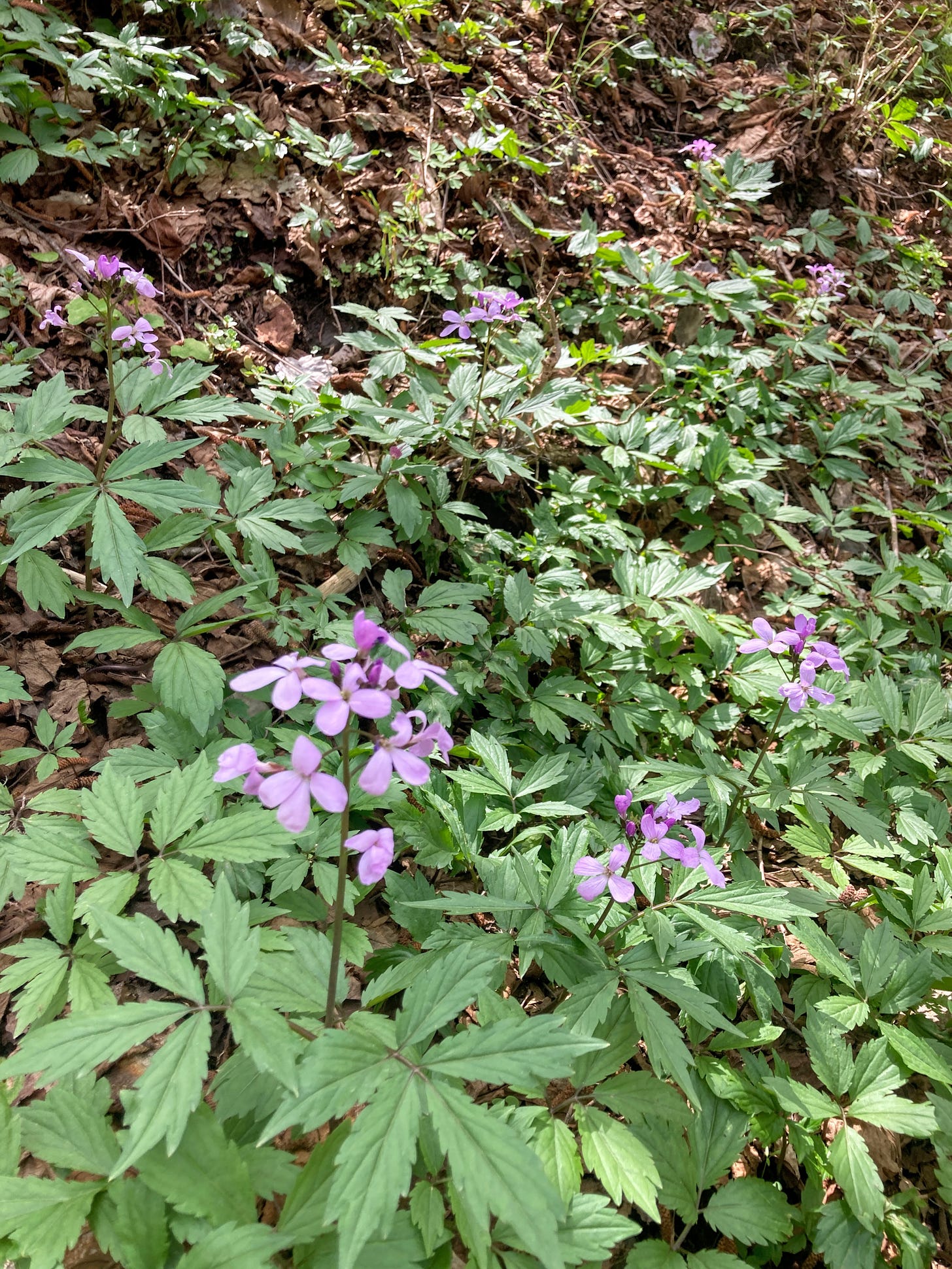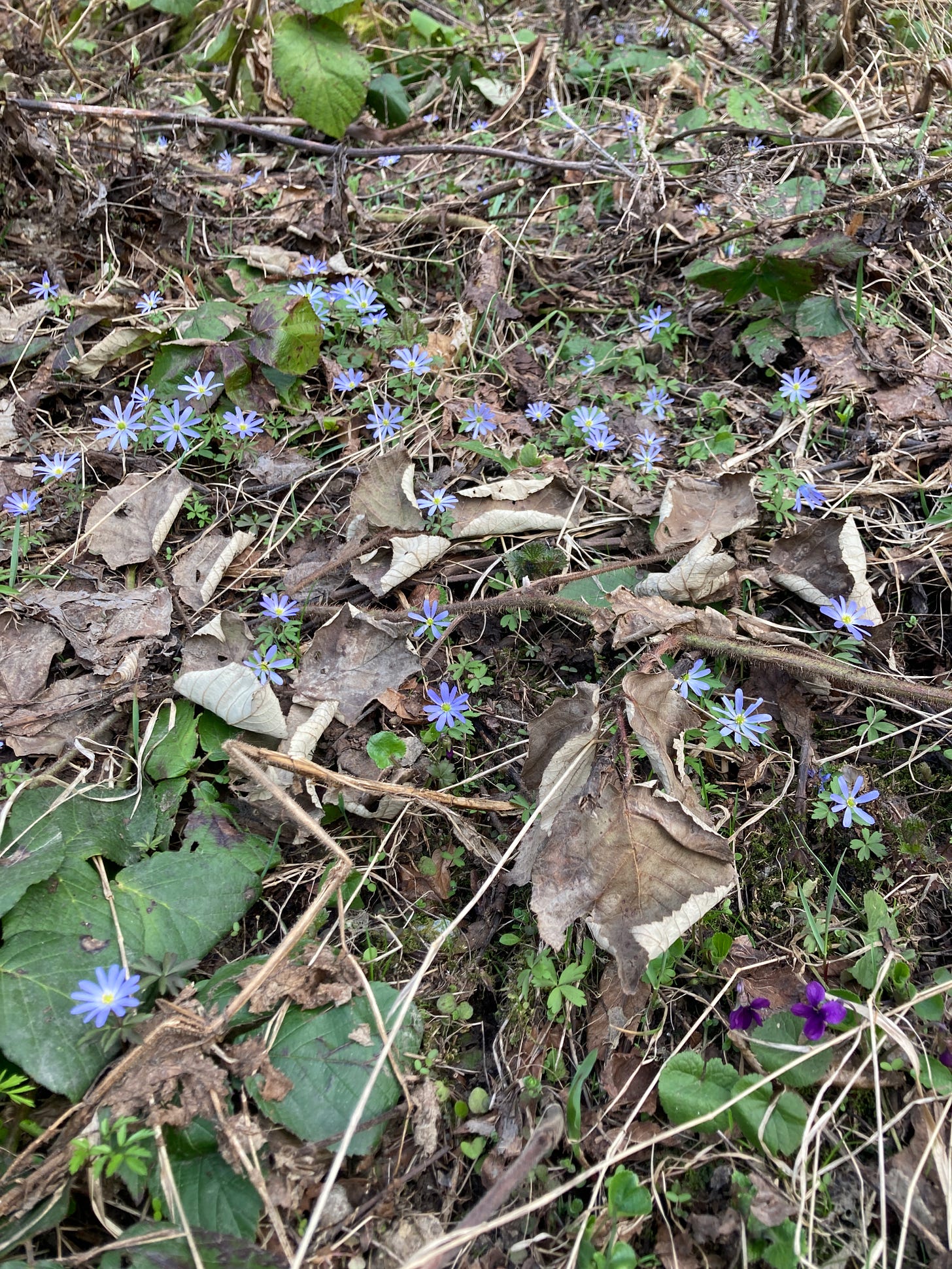Here is a violet
Spring ephemeral wildflowers and "sour" springwater sources in the Gujaretisqali canyon
Georgian intellectual Iakob Gogebashvili (1840-1912) pioneered the Georgian language literacy movement. He published the illustrated primer დედა ენა (Deda Ena/Mother Tongue: Alphabet and the first reading book”) in 1865. The book’s first lesson is the palindrome “აი ია”: what one would say when spotting a violet emerging from the brown leaves of spring woodlands. Both the phrase—“აი ია”—and the violet itself, communicate empowerment, emergence, and persistence of Geogian culture. Gogebashvili demonstrates that a poetic sentence can be conjured with only two letters, and it signifies the endurance of the Georgian language against Russification. With his later encyclopedia ბუნების კარი(Bunebis Kari, or “Door to Nature”) Gogebashvili linked local landscape knowledge landscape with Georgian culture and identity.
In this month’s post on Georgian landscapes, we are pointing at violets and discovering mineral springs in the Gujaretisqali canyon in the Borjomi region.
Tsaghveri is a small town known for its distinctive-tasting მჟავე (mzhave or “acidic iron”) mineral water. Prescribed for the treatment of gastric disorders, it was once sold under the “Tsaghveri” label alongside the more neutral Borjomi mineral water. Tsagveri’s central park features three springs, stained red with iron-red mineral deposits.
The Resort has mineral water springs the waters of which belong to acidulous, hydrocarobate, magnseisum calcium sodium variety with a salination of 3 to 5 g/l. Waters of some springs contain up to 45 mg/l of ferrum and also other so-called biologically active microelements. The waters are used for curative drinking.
-Health Resorts of the Georgian SSR, 1982

Tsaghveri is a rural village with many beautiful examples of 19th and 20th-century wooden architecture. However, like many Georgian villages, its public realm has degraded significantly in the post-Soviet era.
The Borjomi-Bakuriani narrow gauge railway makes a switchback in Tsagveri as it climbs from the Gujaretisqali canyon to the Tsemi plateau and into the Borjomula canyon. There is large railway platform, rail station, historic rolling stock, and complex of maintenance buildings. The major sanatoria include Kechkhobi and the Georgian Railway Worker’s Children’s Sanotorium (abandoned).
The restored Timotesubani church, a significant architectural monument, designed during Queen Tamar’s reign (r. 1184-1213) is located 3km from Tsaghveri center.Features of the lower canyon include columnar basalt cliffs, waterfalls, and the 10th-century Uznariani Fortress.
The area suffered two major forest fires recently: once in 2008 during the Russian invasion of Georgia, and the second in 2017.
Exploring Gujaretisqali Canyon
The canyon of the Gujaretisqali river flows west from the high peaks around Bakuriani through the village of Gujareti, about 24 kilometers from Tsaghveri. This Gujaretisqali watershed supplies much of the municipality’s drinking water. As there are no paved roads, the area remains undeveloped relative to nearby Bakuriani and the Borjomi plateau.
There are several abandoned sawmills and lumber camps in the lower canyon. During the Soviet era, village farmers at the upper elevations produced a range of fresh dairy products for Borjomi’s sanatoria.
Where mountain ravines join the Gujaretisqali are oncrete spring-heads of mzhave waters. Some are protected and feed IDS Borjomi’s bottling plants while others appear abandoned and flow freely. IDS Borjomi ceased operations in April 2022 because of wartime financial sanctions imposed on Russian businesses.

აი ია
Mid-April begins the second wave of spring ephemeral wildflowers, such as Primula varieties, Cardamine quinquefolia (“black sea toothwort”) and Anemone caucasica.


Hardwood species were on the cusp of blooming and leafing out, including Betlua carpinifolia, Crataegus pentagyna, Carpinus Betula, Corylus avellana (hazelnut), and Alnus barbata, and the finely-branched Pyrus caucasica.

Two evergreen species dominate northern slopes: Picea orientalis, with bright green new growth, and Abies nordmanniana, both popular species propagated in the US and EU as Christmas trees. Harvesting nordmanniana cones is a dangerous but lucrative job, as shown in this short documentary made by our colleagues Rayhan Demytrie and Robin Forestier-Walker.
Next month—if road conditions permit—we will continue to the upper reaches of the canyon, to the villages of Tsinubani and Gujareti.








